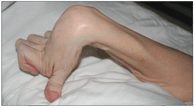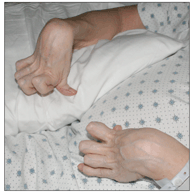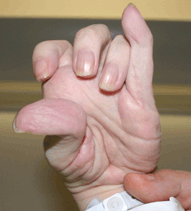A Woman Whose Knuckles Are All Bent Far Backwards
A 62-year-old woman admitted to behavioral hospital unit because of agitation complicating end-stage Parkinson disease. The disease has progressed over 20 years.
This article was originally presented as an independent educational activity under the direction of CME LLC. The ability to receive CME credits has expired. The article is now presented here for your reference. CME LLC is no longer responsible for the presentation of the article.
HISTORY

A 62-year-old woman admitted to behavioral hospital unit because of agitation complicating end-stage Parkinson disease. The disease has progressed over 20 years.
States that hand deformities arose more recently. Gives equivocal answer when routinely queried about remote or recent abuse by others; denies that interpersonal violence ever caused a fracture. Claims that a fall down stairs led to hand changes.
PHYSICAL EXAMINATION
Profoundly dysphonic woman, polite but often unfocused in discussion. Hands as shown. Wrists cannot be passively extended; metacarpophalangeal joints cannot be flexed. Interphalangeal joints are somewhat mobile, distal more so than proximal; passive motion does not produce pain.
Hands warm and well perfused; pulses can’t be felt because of constant abnormal involuntary movements. Movements may be partly psychogenic. Forearms do not feel woody. Elbows show normal passive range of motion. Sensation testing intact.
Legs: atrophy of muscles. Right clubfoot deformity, left foot somewhat inverted and adducted.
What’s Your Diagnosis?
What’s Your Diagnosis?
ANSWER: VOLKMANN ISCHEMIC CONTRACTURES, BILATERAL
The hands and wrists are affected symmetrically apart from sparing of the fifth finger on the left side only (Figures 1, 2, and 3). The upper arms and forearms show no diagnostic changes. Sarcopenia and muscular atrophy are present throughout all limbs as well as the trunk.
The wrists show severe but not unprecedented flexion contractures. Far more striking and aberrant are the metacarpophalangeal deformities; these look extremely painful in that the fingers are bent back so sharply. We could not find any tendon defect in the palm, so we could not infer disruption of tendon pulley as a cause of the disfigurement. Dorsal tendons appear intact on the atrophic back of each hand (see Figure 2).

The fingers are flexed at both interphalangeal joints but show more mobility than the other joints. The fingers do not dig into the palm (see Figure 3). Each thumb is laterally deviated and, in contrast to the fingers, shows hyperextension rather than flexion at its interphalangeal joint. The skin is warm and not pallid, though the surface is somewhat shiny.
We didn’t recognize the pattern, nor did we find a label in the medical records available for review. Information was studied about deformities that complicate Parkinson disease. Nothing remotely related was discovered.
Then we sought further clarification from the patient, from her older medical records, and from the literature. She first asserted that rheumatoid arthritis had been blamed for the changes; we found no such lesions in reviewing the many upper-limb deformities described at one or another stage of rheumatoid arthritis. Our reexamination of the patient was equally unconvincing: no clinical synovitis or any other feature of active rheumatoid disease, nor any pattern we recognize as burnt-out rheumatoid arthritis.
Eventually a best (imperfect) diagnosis emerged: Volkmann ischemic contracture.1-4 Though this was an “Aha!” moment, the patient denied ever hearing the term applied to her case.

FINDINGS IN VOLKMANN CONTRACTURE
This patient's hands show a unique pattern of deformity best explained as Volkmann ischemic contracture, a dreaded sequela of compartment syndrome. Unrelieved compartment syndrome leads to infarction of the flexor digitorum profundus muscle, and then to contracture of the scar remnant. The result is functional and cosmetic catastrophe for the entire wrist-hand unit. This sequence can occur in children following supracondylar fracture of the humerus, eventuating in a severely contracted and functionless forearm. It can also arise from other causes.
Clinically, in a Volkmann contracture the wrist is flexed as our patient’s was; a clawhand deformity is formed because the metacarpophalangeal joints are hyperextended and the proximal and distal interphalangeal joints are flexed. In the staging of the condition, our case best fits stage IV, the second worst.4 The fifth finger on one side was minimally affected-which likely means that the ulnar nerve was relatively spared,4 a known subtype.

WHAT FEATURES DEVIATE FROM EXPECTED?
Extreme deformity of joints from the metacarpophalangeal on distally fits the diagnosis perfectly. However, the expected absence or decrease in sensation to the hand was not present, suggesting-if the patient did not mislead us-that the degree of nerve injury was startlingly little for a Volkmann contracture of this degree.
The forearm is often visibly atrophic compared to its opposite,2 and to musculature elsewhere in the body. Our patient’s was not, but bilaterality hindered the one assessment, and generalized sarcopenia the other. The forearm should be fixed in pronation, and was not.
Bilaterality is not expected unless the same injury, by some horrendous fate, befalls both arms. Yet there was no known antecedent compartment syndrome.
CAUSES OF COMPARTMENT SYNDROME
In compartment syndrome, increased tissue pressure within a confined anatomic space (closed space) impairs the arterial flow required to oxygenate muscles and nerves. If relief of this critical ischemia is delayed beyond 8 hours, nerve and muscle necrosis follows; then both structure and function are compromised, often irreparably.5-7
This sequence begins with any injury that causes increased pressure in a closed compartment either through extrinsic or intrinsic pressure. Trauma is the most frequent cause via crush injury or any source of bleeding or transudation of fluid. Tight dressings or casts can compress arterial flow even without any tissue leakage. Insidious onset can follow thermal or chemical burns if circumferential eschar production chokes venous return and leads to venous congestion so severe as to prevent arterial perfusion.
Many other paths can lead to the profound fluid accumulation that eventuates in compartment syndrome. Among these are snakebite; reperfusion leakage after 4 to 6 hours of critical limb ischemia; edema in anasarca; and spontaneous hematomas due to coagulopathy or to therapeutic anticoagulation or to thrombolysis.
Sequelae of compartment syndrome include myonecrosis followed by muscle fibrosis that ultimately becomes contracture. The contractures constitute the structural announcement of the profound functional debility, and a further source of difficulty in themselves via pain and via further impeding whatever residual contractile function remained to act upon the joint in question.
WHEN TO CONSIDER COMPARTMENT SYNDROME
Compartment syndrome rises in the differential diagnosis whenever pain is disproportionately great in an acute injury. Of course, emotional amplification and secondary gain can exaggerate reported pain; often clinical exclusion of such elements is straightforward.
Clinical findings in compartment syndrome often include a swollen, tense, painful region, sensory deficits, and eventual motor dysfunction. The most reliable finding of compartment syndrome is pain on passive stretch of the involved muscle. Such pain classically is persistent, progressive, and not relieved by immobilization. It is by no means pathognomonic; a torn muscle, or a myohematoma among things, might mimic the features even without complication, but might also lead to a true compartment syndrome.
A flawed mnemonic persists: 5 “P”s of compartment syndrome:
• Pain: an early and sensitive sign albeit highly nonspecific.
• Paralysis (of the muscle group involved) is usual.
The other elements are much less sensitive:
• Pulselessness: late and undependable.
• Pallor: one ought not wait for this.
• Paresthesia: inconsistent.
Thus an incomplete pentad ought never deter a putative diagnosis and the necessary surgical consultation. The surgeon may perform direct manometric tissue pressure measurements, or exploration including for decompression via fasciotomy.

DID SHE EVER HAVE COMPARTMENT SYNDROME?
None of our patient’s findings indicate compartment syndrome at present. Did she have this in the past, leading to the Volkmann deformity?
Although her dysphonia is profound, her cognition imperfect, and her affect clouds some responses, this woman tried her best to tell us all about the development of her hand and wrist changes. She did not recall any cast or fracture and did not recognize the term “compartment syndrome.”
It is possible that she had injuries that went unattended for months or years and first came to attention after the completion of florid contracture, but we must acknowledge a level of uncertainty about the sequence of injury and mal-repair.
Presently, when she has requested purely palliative care, we cannot justify imaging merely to satisfy our curiosity about the state of the muscles, tendons, and nerves of the forearm. We know that Volkmann contracture can occur without ischemia, from cysticercosis of muscles among many other rare causes,8 so we cannot even make a good guess about which prospective cause applied. We’d be grateful for any thoughts from readers that would move us forward.
CAN WE GENERALIZE?
We started with a sign that was utterly unfamiliar and then found a “best match” that had the half-familiarity of having been mentioned in medical school but never seen (or at least never recognized) by either author. Our look at the literature on Volkmann contracture, starting with the initial clinical report,1 underscored profoundly varied and confusing proposed mechanisms of pathogenesis. Even when the role of compartment syndrome emerged, controversy about this syndrome abounded: an infinity of speculations, some supported by experiment, but many mutually contradictory until satisfactory unifying hypotheses and mechanisms became established.5 Perhaps in that context, our confusion about the sign, and our still unanswered questions about this case, can be viewed with tolerance and forgiveness.
Along the way we read extraordinary reports of Volkmann contracture in hemophilic myohematomas, in a paper from 73 years ago9 that proved remarkably insightful and even prescient about mechanism, and another that dissected multiple pathophysiological strands in Volkmann contracture following carbon monoxide poisoning, supported by multiple muscle biopsies and much astute rational inference, dating back to 1967.10
HOW MUCH MORE WAS GOING ON
We also saw, again, how readily an astounding abnormality can remain unlabeled when overall status and functional problems command all attention of the medical team. In this patient, though one would think the hands and wrists would never stop hurting, she insisted that her chronic opiate requirement related to back pain, not to the upper limbs. Finally, we noticed that the clubfoot deformity11 (Figure 4) stood even further down on the list of unnamed problems than the hands, and appeared to have developed entirely independently of them, perhaps akin to the pes equinus sometimes seen years after loss of ambulation.12
These experiences validated the old dicta, “Avoid a too-tight tourniquet in controlling bleeding in the field” and “You can indeed bandage too tightly.” Any suspected compartment syndrome calls for early consultation and very likely a procedure, though fasciotomy may be contraindicated in some acute muscle crush-injury–related compartment syndromes.5 We’d like to play our small part in reducing the chance of ever seeing another Volkmann contracture.
Schneiderman H, Kumar S. Volkmann ischemic contracture in a woman with end-stage Parkinson disease and a host of unanswered questions. CONSULTANT. 2009;49:447-451.
References:
REFERENCES:
1.
Von Volkmann R. Ischaemic muscle paralyses and contractures. 1881. BickEM, trans.
Clin Orthop Relat Res.
2007;456:20-21.
2.
Benkeddache Y, Gottesman H, Hamidani M. Proposal of a new classificationfor established Volkmann's contracture.
Ann Chir Main.
1985;4:134-142.
3.
Von Schroeder HP, Botte MJ. Definitions and terminology of compartmentsyndrome and Volkmann's ischemic contracture of the upper extremity.
HandClin.
1998;14:331-334.
4.
Hovius SE, Ultee J. Volkmann's ischemic contracture. Prevention and treatment.
Hand Clin.
2000;16:647-657.
5.
Klenerman L. The evolution of the compartment syndrome since 1948 asrecorded in the JBJS (B).
J Bone Joint Surg Br.
2007;89:1280-1282.
6.
Lester B. Compartment syndrome. In: Lester B, ed.
The Acute Hand.
Stamford,CT: Appleton & Lange; 1999:347-359.
7.
Thoder JJ. Compartment syndrome. In: Jebson P, Kasdan M, eds.
Hand Secrets
.3rd ed. Philadelphia: Mosby Elsevier; 2006:102-107.
8.
Jain V, Sen B, Agrawal M, et al. Volkmann sign of non-ischaemic origin.
J HandSurg Eur.
2008;33:462-464.
9.
Hill RL, Brooks B. Volkmann's ischemic contracture in hemophilia.
Ann Surg.
1936;103:444-449.
10.
Orizaga M, Ducharme FA, Campbell JS, Embree GH. Muscle infarctionand Volkmann's contracture following carbon monoxide poisoning: a case report.
J Bone Joint Surg [Am].
1967;49:965-970.
11.
Okechukwu C, Schneiderman H. Clubfoot deformity (talipes equinovarus).
Consultant.
1999;39:501-502.
12.
Schneiderman H, Noteroglu EH. Bilateral talipes equinus deformities in anaged bedbound demented woman.
Consultant.
2005;45:783-789.
